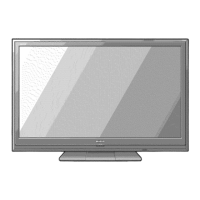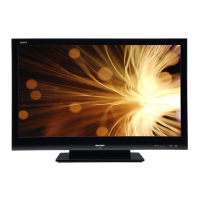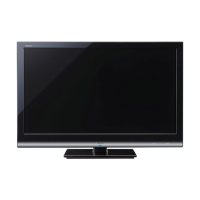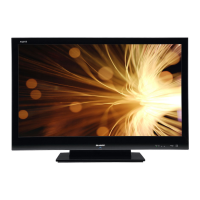On-Screen Display Menu
CH Setup
If initial setup does not memorize
all
the channels
in
your region, follow the instructions below
to
manually
memorize the channels.
Air/Cable: Make sure what kind of connection
is
made
with your
1V
when selecting "Air" or "Cable".
CH
Search: Channel auto search makes the
1V
look for
all
channels viewable
in
the set area.
CH Memory: You can select the channels to skip
in
each
ANALOG
(Air),
ANALOG (Cable), DIGITAL
(Air)
and
DIGITAL (Cable).
On: Skips channels. (Channel selection disabled using
CH
!\/V·)
Off: Does not skip channels. (Channel selection enabled using
CH!\/V·)
Remove Scrambled CH: This function makes the
1V
look for and then delete digital cable channels that
are scrambled and so unavailable
in
the set area. The
process may take more than 20 minutes.
Yes: Starts to remove scrambled channels.
No: This function does not work.
mm
• See "Initial Setup" on page 15 for setting each item.
•
If
no channel
is
found, confirm the type of connection made
with your
1V
and try channel search again.
•
If
you select "Analog Search Start" and initiate the channel
search, the CH Memory for Cable Digital will be deleted.
Antenna Setup-DIGITAL
In
order
to
receive digital air broadcasts, you need
a digital broadcast antenna. You can confirm the
antenna configuration through the "Antenna Setup-
DIGITAL" screen.
If
necessary, adjust the direction
of
the antenna to obtain the maximum signal strength.
Signal Strength: The signal strength of DIGITAL channel
is
displayed. The signal information
is
based on the
current channel.
Channel Strength: Input the 2-digit channel number
to check the signal strength
of
the selected channel.
Make sure the signal
is
strong enough for each
channel.
• This function
is
available for DIGITAL
(Air)
only.
Input Skip
This setting allows you to skip the HOMI or PC-IN Input
("Input 4 (HOMI)", "Input 5 (HOMI)", "Input 6
(HOMI)"
and "Input 7 (RGB)") on the Input Selection operation.
Yes: Skips the input.
No: Does not skip input.
Input Label
Lets you set the input terminal displayed when using
the INPUT SOURCE menu or channel display. Press
JilT
I
....
/~
to select the new name for the input
mode.
• Using the software keyboard, you can enter up
to
10
characters for text. (See page 40.)
cmD
• You cannot change labels
if
the INPUT SOURCE
is
1V.
Input Signal
(for Analog PC Input
Mode
Only)
Some input signals may have to be registered manually
to display properly. The pair of input signals (resolutions)
in
the list below
is
not distinguishable when received.
In
such a case, you have to set the correct signal
manually. After setting once, it will display when the
same signal (resolution)
is
input again.
11024 x 768 1360 x 768 I
cmD
• You can only select the "Input Signal" on the Setup menu
when receiving one
of
the 2 input signals listed above.
Auto Sync. Adjustment
(for Analog
PC
Input
Mode
Only)
For automatically adjusting the
PC
image.
Yes: Auto Sync. starts and "Now adjusting the image."
displays.
No: This function does not work.
cmD
• When Auto Sync.
is
successful, "Completed" displays.
If
not, Auto Sync. failed.
• Auto Sync. may
fail
even
if
"Completed" displays.
• Auto Sync. may
fail
if
the computer image has low
resolution, has unclear (black) edges,
or
is
moved while
executing Auto Sync.
• Be sure to connect the
PC
to the
1V
and switch it on before
starting Auto Sync.
Fine Sync. Adjustment
Ordinarily you can easily adjust the picture
as
necessary to change image position using Auto Sync.
In
some cases, however, manual adjustment
is
needed
to optimize the image.
H-Pos.: Centers the image by moving
it
to the left
or
right.
V-Pos.: Centers the image by moving
it
up or down.
Clock: Adjust when the image flickers with vertical
stripes.
Phase: Adjust when characters have low contrast
or
when the image flickers.
mm
• For resetting
all
Fine Sync. adjustment items to the factory
preset values, press
./~
to select "Reset", and then press
ENTER
•
It
is
not necessary to adjust the "Clock" or "Phase" when a
digital signal
is
being input, so it cannot be selected.
• The default cursor position may not be
in
the center,
because the screen position variable ranges may be
asymmetrical.
• The screen position variable ranges depend on the View
Mode or the signal type. The ranges can be seen on the
position-setting screen.
@-
25

